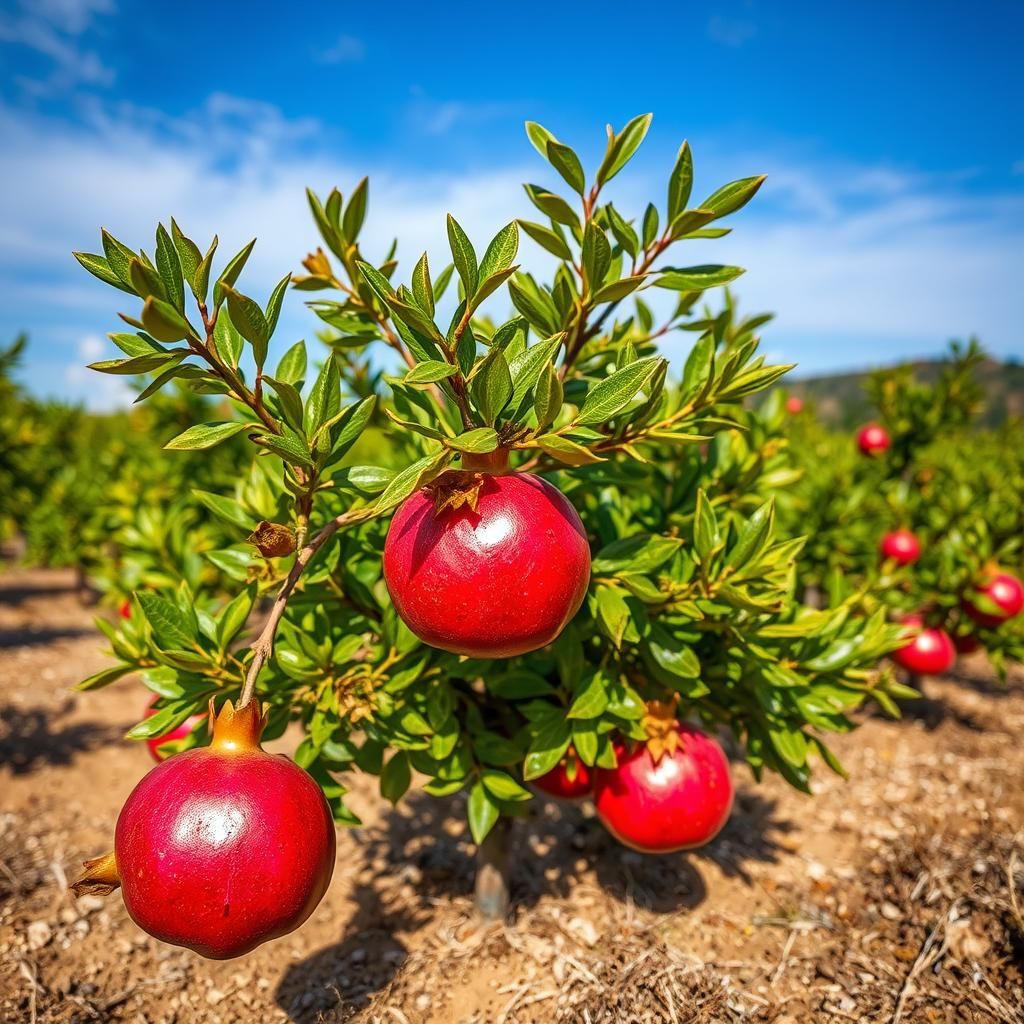Discover Where Do Pomegranate Trees Grow: Ideal Regions and Growing Conditions

Pomegranate trees, known for their vibrant fruit and striking flowers, thrive in specific climates and conditions that ensure optimal growth. Understanding where these trees flourish can greatly enhance your chances of successful cultivation. This article will explore the ideal regions for pomegranate cultivation, outlining the climatic preferences, soil requirements, and other essential factors that contribute to their health and productivity. From arid landscapes to Mediterranean climates, we will uncover the best environments to grow pomegranate trees and provide valuable insights for gardeners and farmers looking to harness the bounty of this ancient fruit-bearing species.
Where Do Pomegranate Trees Grow?
Pomegranate trees, known scientifically as Punica granatum, thrive in warm, dry, and subtropical climates, making them well-suited for growth in regions with long, hot summers and mild winters. Commonly found in countries such as Iran, India, and parts of the Mediterranean, these trees prefer well-drained soil and can tolerate poor conditions, allowing them to flourish in arid regions with limited water. Their adaptability makes them versatile, enabling them to be cultivated in home gardens, orchards, and landscapes around the world, particularly in USDA hardiness zones 8 through 10.
Climate Requirements
Pomegranate trees require a warm climate for optimal growth, ideally enjoying temperatures between 50°F (10°C) and 104°F (40°C). They are best suited for areas that experience long, hot summers and can withstand temperatures down to about 12°F (-11°C) during the winter. This range of temperatures promotes healthy flowering and fruitful yields, while excessive moisture, especially during the colder months, can lead to disease and decreased productivity.
Soil Conditions
For successful cultivation, pomegranate trees prefer well-drained soil that is slightly acidic to neutral, with a pH range of 5.5 to 7.0. Poorly drained or overly compacted soils can lead to root rot and other problems. Adequate drainage is crucial because these trees are adapted to environments with low precipitation. Regular soil amendments with organic matter can improve the structure and nutrient content, promoting healthy tree development and fruit production.
Geographical Distribution
Pomegranate trees are native to regions in the Mediterranean and parts of the Middle East, with significant cultivation in countries like Turkey, Greece, Spain, and particularly India, which is the largest producer globally. They are also grown in California in the United States, where the warm climate closely resembles their native habitat. This geographical spread highlights their adaptability to different climates, allowing them to be cultivated in various locations worldwide.
See also:
Watering Needs
While pomegranate trees are drought-tolerant, they require regular watering during the establishment phase and during critical development stages, such as flowering and fruit set. Drip irrigation is often recommended, as it provides consistent moisture without waterlogging the roots. Once established, the trees can survive on minimal water, but to achieve optimal fruit size and quality, a moderate but consistent irrigation schedule should be maintained, especially in dry periods.
Cultural Practices
Effective cultural practices such as pruning and fertilization are essential for healthy pomegranate tree growth. Pruning should be done during the dormant season to promote airflow and minimize disease risk, while also ensuring adequate sun exposure for the fruit. Fertilization, ideally with a balanced fertilizer rich in potassium, enhances fruit production and tree vigor. Regular monitoring for pests and diseases, along with the right cultural practices, contributes to a fruitful harvest.
| Factor | Ideal Condition |
|---|---|
| Climate | Warm, dry regions |
| Soil | Well-drained, slightly acidic to neutral |
| Watering | Moderate, especially during critical stages |
| Geography | Native to Mediterranean and Middle Eastern countries |
| Fertilization | Balanced fertilizers, rich in potassium |
Optimal Climate and Soil Requirements for Pomegranate Growth
Pomegranate trees thrive in warm, dry climates, making them ideally suited for regions with long growing seasons and plenty of sunshine. They prefer mildly temperate to subtropical environments, as they require at least six hours of direct sunlight each day to flourish. These trees are known for their adaptability, but they perform best in well-drained soils with a pH of around 5.5 to 7.0. Adequate drainage is crucial, as pomegranate trees are highly susceptible to root rot in overly wet conditions. Consequently, the most successful regions for pomegranate cultivation include areas such as the Mediterranean, parts of California, and regions in Iran and India, where conditions align with their natural habitat.
Best Regions for Pomegranate Cultivation
Some of the best regions for cultivating pomegranate trees include the Mediterranean Basin, which offers the warm, arid climate favorable for their growth. Additionally, parts of Southern California have emerged as significant areas for pomegranate farming due to the region's ideal combination of temperature and sunlight. Countries like India and Iran are also prominent in pomegranate production, as they have landscapes that support extensive orchards thriving in hot, dry conditions. These regions not only provide the right climate but also have a rich history of cultivating pomegranates, leading to specialized knowledge in their care.
Watering Needs and Irrigation Practices
Pomegranate trees have specific watering needs that vary based on their growth stages. While young trees require more frequent watering until they establish deep roots, mature trees are more drought-resistant and prefer to dry out between watering. Implementing effective irrigation practices is essential, particularly in regions with limited rainfall. Drip irrigation is often recommended as it delivers water directly to the roots, minimizing evaporation and ensuring that the trees receive the moisture they need without becoming waterlogged, which can lead to disease.
See also:
Soil Preferences for Pomegranate Trees
Soil in which pomegranate trees are planted should be well-draining and rich in organic matter. These trees prefer sandy or loamy soils, as compacted or clay-heavy soils can hinder root development and lead to root rot. Additionally, the ideal pH range for pomegranate trees is slightly acidic to neutral (5.5 to 7.0). Regular soil testing can help determine nutrient levels, ensuring adequate fertility and promoting healthy growth, which is crucial for optimal fruit production.
Temperature Tolerance for Pomegranate Growth
Pomegranate trees are quite temperature-tolerant, flourishing best in temperatures ranging from 70°F to 80°F (21°C to 27°C). However, they can withstand temperatures as high as 100°F (38°C) during the day, as long as they receive adequate water. Conversely, they are vulnerable to extreme cold, with temperatures below 10°F (-12°C) potentially damaging the fruit and foliage. Therefore, planting in areas that maintain mild winters and have minimal frost risks is essential for ensuring healthy growth and fruitful yields.
Common Pomegranate Diseases and Pest Management
While pomegranate trees are relatively resistant to diseases, they can still be affected by issues such as leaf spot, fruit split, and pest infestations like aphids and mealybugs. Good cultural practices, including proper watering, pruning, and maintaining soil health, are critical to preventing these problems. Additionally, organic methods such as introducing beneficial insects or applying neem oil can effectively manage pests while minimizing chemical intervention. Regular monitoring for signs of disease or pest infestation is also vital to ensuring the health and productivity of pomegranate trees.
Questions from Our Readers
Where do pomegranate trees grow naturally?
Pomegranate trees primarily grow in warm, temperate regions and are native to areas in Southeast Asia, particularly Iran and the Mediterranean. They thrive in regions with hot, dry summers and cool winters, making places like California, Spain, and parts of the Middle East ideal for cultivation.
Can pomegranate trees grow in cooler climates?
While pomegranate trees prefer warmer climates, they can tolerate mild frost and can be grown in cooler regions if they're planted in protected areas or sunny spots. However, extreme cold can damage the trees, so growing them in pots allows for winter protection in areas with harsher conditions.
See also:
What soil conditions are best for pomegranate trees?
Pomegranate trees thrive in well-drained soils that are rich in organic matter. They are adaptable but prefer soils that are slightly alkaline or neutral in pH. Ensuring proper drainage is essential to prevent root rot, which can occur in overly wet soils.
Are pomegranate trees suitable for indoor growth?
Yes, pomegranate trees can be grown indoors, particularly the dwarf varieties that are more suited for container life. They need plenty of sunlight, ideally around 6 hours per day, and should be placed in a bright, sunny location with adequate drainage to thrive in an indoor environment.

If you want to read more articles like Discover Where Do Pomegranate Trees Grow: Ideal Regions and Growing Conditions, we recommend you check out our Seeds category.
Leave a Reply
Related Articles